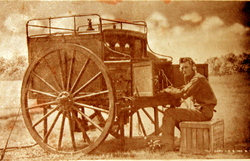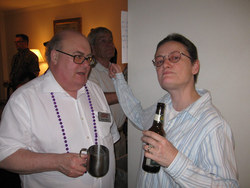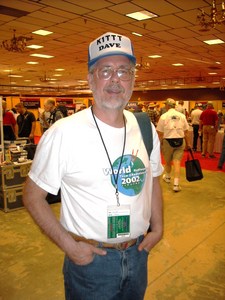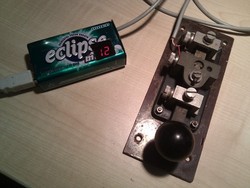 June 9, 2010 Editor: Ward Silver, NØAX | |||||
IN THIS ISSUE
NEW VHF+ OPERATORS - THINGS TO DO Let's turn the tables and encourage HF operators to try out those funny "50" and "144" and other buttons that send their all-band, all-mode rigs above 30 MHz. This weekend is the ARRL June VHF QSO Party and there will be lots of folks to work. Start near the weak-signal calling frequencies and be prepared to change bands! BULLETINS There are no bulletins in this issue. BUSTED QSOS A golden issue managed to be put out last time! CONTEST SUMMARY Complete information for all contests follows the Conversation section June 12-13
June 19-20
NEWS, PRESS RELEASES, AND GENERAL INTEREST The recent brouhaha over 2009 IARU HF Championship logs from DAØHQ has been addressed by the ARRL as the administrator of the contest. The full statement is online at the ARRL Contest Branch blog. In a nutshell, while individual German amateurs may have violated the rule of one-call-per-transmitter in making many questionable QSOs, there is no evidence that the DAØHQ team solicited that behavior. As a result, no overall winner's certificate will be awarded for the 2009 contest - only continental leaders certificates. More importantly, effective with the 2010 contest, HQ logs will not be adjudicated, nor will scores for HQ stations be published. All logs may be made public at the discretion of the contest administrator, i.e. the ARRL. HQ stations will continue to be multipliers in the contest. Thanks to Dean N6BV's Propagation Predictions software, there is a new set of customized propagation forecasts for WRTC-2010 participants. Inside the ZIP file there are four PDFs for Very Low SSN and Low SSN conditions at 100 and 1500 watts. This will help you find the WRTC stations (R3ØA-R39Z) just as well as it helps them find you! With the event just a month in the future, this is good information to help everyone prepare to participate effectively. (Thanks, Bob N6TV) Doug K1DG found some links to "official" ITU Zone maps and corner coordinates. While individual contest sponsors may redefine these zones to some degree, this is a good place to start. Note that the zones do not always follow state boundaries in the US! The PVRC and NCCC are pleased to post another joint webinar with Dean N6BV on "Tactical Use of Propagation Predictions for HF Contesting". Held on June 7, Dean illustrated some "how-tos" with numerous area coverage maps. The video will be on-line soon, so be patient until it is posted. (Thanks, Dean N6DE) Dave W9ZRX announces the availability of an update to his VHF_USA Databases has been made available for download, just in time for this weekend's ARRL June VHF QSO Party. This version of the database contains 13,816 calls - mostly Canadian, Mexican, and US. It's available in a variety of formats, too.
Silva LU1DZ notes that the rules for the World Wide South American CW Contest (it runs this weekend!) are now available in six languages; - Castilian (Spanish), English, German, Romanian, Portuguese, and French. All-in-one software by WD8KNC that includes WWSA is also available. If your band-country totals for South America are low, here's a chance to log our neighbors to the south! The BARTG "Sprint 75" contest throws a bit of a monkey wrench into your RTTY works as it requires operation at 75 baud instead of the standard 45.45 baud. You can find the steps for getting WriteLog running at on Don AA5AU's Web site. For N1MM Logger users, MMTTY can be used in AFSK mode at higher speeds. Also, the MMVARI and FLDIGI engines are options within N1MM Logger that you can use. A standalone version of MMTTY can be used in AFSK mode. It can also be used when it is directly driving a COM port in FSK mode. The COM/FSK solution is typically limited to older computers running Windows 98 or older. (Thanks, Bob KØRC) Field Day's a-comin' and how are you going to pick up those satellite bonus points? The Radio Amateur Satellite Corporation (AMSAT) promotes its own version of Field Day for operation via the amateur satellites, held concurrently with the ARRL event, and the AO-51 Command Team and Operations Group has announced the AO-51 configuration for Field Day: June 24 09:35Z - June 27 06:40Z FM Repeater, V/U June 27 06:40 - June 27 22:00Z FM Repeater, V/S Please observe the 1 QSO per repeater Field Day rule! The latest AO-51 Command Team and Operations Group News is a good Web site to visit to keep tabs on AO-51 operation. (From AMSAT News Bulletin ANS-157) Will the next solar cycle turn out to be bust or boom? We don't know, for sure, but we do know that it will be the most closely-watched cycle ever. This story from NASA discusses all the new observing capabilities that will be reporting on our stellar parent. Today's NASA Earth Observatory also features an article on solar variability. (Thanks, Donald WB5VNI) Web Site of the Week - In the hills of New Hampshire lurks a "giant golf ball" and like all inquisitive souls, we wonder what could be inside the giant golf ball. It turns out to be MIT's Haystack radio observatory! Recent upgrades cracked open the golf-ish globe, exposing the observatory as documented in this online collection of photos. (Thanks, Rich KL7RA) WORD TO THE WISE EDZ - short for Extended Double Zepp, this wire antenna is a Field Day secret weapon. On its design band, the antenna 1.28-wavelengths long and has about 3 dBd free-space gain. If fed with low-loss feed line, such as ladder line, it can be used on multiple bands, too! SIGHTS AND SOUNDS Get out of that chair, slowpoke! Katia RZ9UMA is one fast nine-year-old CW operator! She is blazing in video 1 and video 2 from the recent CQ WW WPX CW contest. Show this to your kids and then stand back! (Thanks, Steve N2IC/5 and Brian OZ2BRN) What did those exquisite conditions during WPX CW sound like from latitude 63 North? Phil KL8DX shows you in the video linked to his blog! (Thanks, Rich KL7RA)
Tom K8CX has posted his massive collection of photos from the 2010 Dayton Hamvention. Enjoy! RESULTS AND RECORDS The expanded Web version of the 2009 ARRL 10 Meter Contest results are now online. You can download the PDF file and other items from the ARRL Contest Results Web page. The complete results package includes the Line Scores and the Searchable Database, too! (Thanks, ARRL Contest Branch Manager, Sean Kutzko, KX9X) Dink N7WA has started a Soapbox page for the recent WPX CW. Browse on over and find out if conditions were really as exceptional as they seemed! OPERATING TIP Spare headphones are a good item to have around, particularly if your regular pair starts aggravating your auriculae or pressing on your pinnae! When you need some relief, just change headphones! TECHNICAL TOPICS AND INFORMATION While "tuning across the 'net" for some technical information, these two Belden documents caught my eye: one on coaxial cable applications and a coaxial cable technical reference. Handy thing, this Internet - think it will catch on? To make your own ladder line, you'll need "rungs" that can stay out in the weather for as long as it takes. Charles W2SH recommends the large, exterior cable staples found in your local home improvement emporium. "Among their wire accessory supplies, you will find some gray plastic staples. Each one carries two 1-1/2-inch nails in to secure the staple to the outside of your house. The manufacturer is Gardner Bender Co." Remove the nails and enlarge the holes to pass #12 or #14 AWG copper wires, creating a feed line with 1-1/4-inch conductor spacing and an impedance of somewhat higher than 450 ohms.
For static dissipation in any antenna, placing a ¼-wavelength shorted stub across the feed line provides a dc path to ground, assuming one side of the feed line is grounded. (Thanks, Dave WX7G) For a computer's serial data port to drive relays, you need a small microprocessor to interpret the data stream, drivers for the relays, and the relays themselves. All this is available in the Velleman K8056 kit that has eight relays and drivers on it. It interfaces to parallel, serial RS-232 or TTL-level signals, and there are other options. The kit has a very simple schematic and an open circuit board that lends itself to all sorts of modifications. (Thanks, Jim W6RMK) Getting the solidified gunk off antennas that have been "out there" for a few years can be quite a chore. Steel wool pads are not recommended because of their tendency to leave iron whiskers embedded in the aluminum (and your hands), causing spot rust and binding problems in nested tubing. Dave WA3GIN suggests a combination of NAPA engine parts cleaner and a 3M medium foam sanding pad. The result is similar to wet sanding with an agent that dissolves or loosens the oxidized stuff so that the pad can break it loose and polish the aluminum. This minimizes the required amount of elbow grease to facilitate the operation. Technical Web Site of the Week - Dick N6AA sends word of a new on-line question-answering Web site, Wolfram Alpha. Start by viewing the introduction so you can begin to learn how to use the service. CONVERSATION It's All In Your Head Opinions abound on the various email reflectors and no topic seems to draw out more of them more reliably than whether or not using a CW decoder of some sort "counts as real CW". Like lots of things, I also have an opinion, but this nice post by Dick K6KR on the cq-contest reflector, beat me through the pileup. 73, Ward NØAX I recall visiting the Samuel F. B. Morse house in Poughkeepsie, NY and saw (perhaps a replica of) Mr. Morse's telegraph machine. Morse's telegraph receiver drew inked marks on a strip of moving paper - the first CW "code reader". The operator had to know (or be able to look up) the dot and dash encoding of each character, but that activity didn't have to occur at any particular speed. Only later was it discovered that humans could listen to the clicking of the telegraph sounder as a substitute for reading the paper strip. I would argue that Samuel F. B. Morse's invention shows that code readers aren't "new technology" at all. Decoding Morse characters from their sound is the newer technology. Few debate the propriety of semiautomatic and automatic keying equipment (CW encoders). As a contest participant that has to listen to some really "creative" bug adjustments, I'm glad most of us do! Why is it such a big leap to a CW decoder? If you have the skills and inclination to decode CW in your head with other CW signals in the audio passband, good for you. You'll be more efficient at decoding than today's electronic code readers. I can't reliably manually encode CW as fast as I can decode bursts. But when I send faster by turning a knob, I'm still operating CW, thank you very much. So is my colleague at the other end with his CW decoder. What we call CW is the transmitted signal encoding, not the means of generating or deciphering it. If it's a straight key, bug, electronic keyer, or a code practice tape machine, it's CW. If someone decodes it in their head or with a machine, it's still CW. If you choose to operate without a CW decoder, or with only a straight key, or only on alternate Saturday mornings, or with only one radio, or enter contests with less than the full arsenal of the permitted technology, you should feel free to do so. Most contest organizers seek ways to draw more participants, not look for reasons to push people away.
I really enjoy CW. I almost always use an electronic CW encoder. The CW encoder I use, and the logging computer, and the comfortable chair, and the other equipment I have around me all "assist" me in improving my contesting experience. I want your CW QSO! Use a CW decoder if you wish. I'm glad you'll be on the radio this weekend. If you hear (or read) me calling CQ, I'd like you to call me. I'm still working to improve my CW decoding skills. Pulling one complete call accurately out of a group of callers and keeping the rate up is something that I'm trying to improve in every contest. When you're in that "zone" and the rate is high... It just feels great! But my contesting sophistication had to evolve to be able to get to this point, and I remain in awe of the skills of many of my colleagues. And I'll keep trying to improve. CONTESTS 9 June through 22 June 2010 An expanded, downloadable version of QST's Contest Corral in PDF format is available. Check the sponsor's Web site for information on operating time restrictions and other instructions. HF CONTESTS Kid's Day--Phone, from Jun 19, 1800Z to Jun 19, 2400Z. Bands (MHz): 3.5-28. Exchange: Name, age, location, favorite color. Rules CWops Mini-CWT Test--CW, from Jun 9, 1100Z to Jun 10, 0400Z. Bands (MHz): 3.5-14. Frequencies (MHz): 18 to 28 kHz above band edge. Exchange: Name and member number or S/P/C. Logs due: 2 days. Rules Bill Windle QSO Party--CW, from Jun 12, 0000Z to Jun 12, 2359Z. Bands (MHz): 1.8-28, 50,144, Frequencies (MHz): 15 to 40 kHz above band edge. Exchange: RST, name, FOC number. Logs due: 14 days. Rules WFF Green Days--Phone,CW,Digital, from Jun 12, 0000Z to Jun 13, 2359Z. Bands (MHz): 1.8-28. Exchange: RS(T) and WFF number if available. Logs due: 30 days. Rules Portugual Day--Phone,CW, from Jun 12, 0000Z to Jun 12, 2400Z. Bands (MHz): 3.5-28. Exchange: RS(T) and serial or district code. Logs due: Sep 1. Rules Australian Shires Contest--Phone,CW, from Jun 12, 0600Z to Jun 13, 0600Z. Bands (MHz): 3.5-28. Exchange: RS(T) and VK Shire or CQ Zone. Logs due: Sep 1. Rules DRCG Long Distance RTTY--Digital, from Jun 12, 0800Z to Jun 13, 2359Z. Bands (MHz): 3.5-28. Multiple operating periods. Exchange: RST, UTC time, and CQ Zone. Logs due: Aug 1. Rules Asia-Pacific Sprint--Phone, from Jun 12, 1100Z to Jun 12, 1300Z. Bands (MHz): 14-21. Exchange: RST, serial. Logs due: 7 days. Rules GACW WWSA CW DX Contest--CW, from Jun 12, 1500Z to Jun 13, 1500Z. Bands (MHz): 3.5-28. Exchange: RST, CQ zone. Logs due: Jul 30. Rules BARTG Sprint 75--Digital, from Jun 12, 2000Z to Jun 12, 2359Z. Bands (MHz): 14-28. Exchange: Serial number. Logs due: Jun 30. Rules World Wide QRP Contest--Phone,CW, from Jun 12, 0000Z to Jun 20, 2400Z. Bands (MHz): 1.8-28, 50-432. Exchange: RS(T). Logs due: Jul 11. Rules SARL Youth Day Sprint--Phone, from Jun 16, 0900Z to Jun 16, 1000Z. Bands (MHz): 7. Exchange: RS and age. Logs due: 15 days. Rules All-Asian DX Contest--CW, from Jun 19, 0000Z to Jun 20, 2400Z. Bands (MHz): 1.8-28. Exchange: RST, operator age (YL may send 00). Logs due: Jul 31. Rules West Virginia QSO Party--Phone,CW,Digital, from Jun 19, 1600Z to Jun 20, 0200Z. Bands (MHz): 3.5-28. Frequencies (MHz): CW--35 kHz from band edge, Phone--35 kHz from General/Nov/Tech segments. Exchange: RS(T), WV county or S/P/C. Logs due: Jul 20. Rules Spanish Islands Contest--Phone,CW,Digital, from Jun 20, 0600Z to Jun 20, 1200Z. Bands (MHz): 3.5-28. Exchange: RS(T), DIE number or serial. Logs due: 60 days. Rules VHF+ CONTESTS ARRL June VHF QSO Party--Phone,CW, from Jun 12, 1800Z to Jun 14, 0300Z. Bands (MHz): 50+. Exchange: Grid square. Logs due: Jul 14. Rules Bill Windle QSO Party--CW, from Jun 12, 0000Z to Jun 12, 2359Z. Bands (MHz): 1.8-28, 50,144, Frequencies (MHz): 15 to 40 kHz above band edge. Exchange: RST, name, FOC number. Logs due: 14 days. Rules REF DDSM Six Meter Contest--Phone,CW, from Jun 12, 1600Z to Jun 13, 1600Z. Bands (MHz): 50. Exchange: RST, serial number, grid square. Logs due: 15 days. Rules World Wide QRP Contest--Phone,CW, from Jun 12, 0000Z to Jun 20, 2400Z. Bands (MHz): 1.8-28, 50-432. Exchange: RS(T). Logs due: Jul 11. Rules WAB 50 MHz Phone--Phone, from Jun 13, 0900Z to Jun 13, 1500Z. Bands (MHz): 50. Exchange: RS, serial, WAB square or DXCC entity. Logs due: 21 days. Rules SMIRK QSO Party--Phone,CW, from Jun 19, 0000Z to Jun 20, 2359Z. Bands (MHz): 50. Exchange: Call sign, SMIRK number, grid square. Logs due: Aug 1. Rules LOG DUE DATES 9 June through 22 June 2010 June 9 - CQ-M International DX Contest, email logs to: CQM@SRR.RU, paper logs and diskettes to: CQ-M CONTEST COMMITTEE, P.O. BOX 25464, KRASNOYARSK 660049, RUSSIA. Rules June 10 - ARS Spartan Sprint, email logs to: spartansprint@yahoo.com, paper logs and diskettes to: (none). Rules June 10 - His Maj. King of Spain Contest, CW, email logs to: smreycw@ure.es, paper logs and diskettes to: URE HF Contests, P.O. Box 220, 28080 Madrid, Spain. Rules June 12 - Nevada Mustang Roundup, email logs to: w7gk_1@yahoo.com, paper logs and diskettes to: Nevada Mustang Roundup 2010, Elko Amateur Radio Club, P.O. Box 5607, Elko, Nevada 89802, USA. Rules June 12 - Wake-Up! QRP Sprint, email logs to: ru-qrp-club@mail.ru, paper logs and diskettes to: (none). Rules June 13 - DigiFest, email logs to: digifest_robot@mixw.net, Upload log, paper logs and diskettes to: (none). Rules June 14 - RSGB 80m Club Championship, Data, Upload log, paper logs and diskettes to: (none). Rules June 15 - Indiana QSO Party, email logs to: inqp@hdxcc.org, paper logs and diskettes to: HDXCC, c/o Mike Goode, N9NS, 10340 Broadway, Indianapolis, IN 46280-1344, USA. Rules June 21 - RSGB National Field Day, Upload log, paper logs and diskettes to: RSGB G3UFY, 77 Bensham Manor Road, Thornton Heath, Surrey CR7 7AF, England. Rules ACKNOWLEDGEMENTS ARRL Contest Update wishes to acknowledge information from WA7BNM's Contest Calendar and SM3CER's Contest Calendar. | |||||










